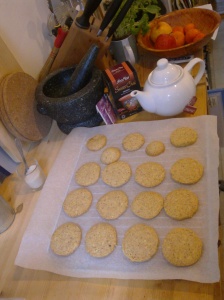I’ve been at home for my family’s annual julefrokost (litterally: Christmas lunch; usually also describes a Christmas party at firms/companies/places of work or other organisations keeping adults busy, it’s a Christmas celebration, but not celebrating Christmas (Eve, Night, or Day(s)) itself. It’s one of the Danish oddities – like hygge).
I knew that my parents (who are the hosts of the family julefrokost) had some Christmas tea (because I bought it for them – they’re not as Christmassy as I am), although it’s not of my favorite teahouse – but my emergency Christmas teahouse. So since I (still?!) have some of my favorite Christmas tea left, I thought I’d bring it – but when I got there, I realized I had forgotten the tea at my place. And when I checked, there was only enough for a pot and a half of Christmas tea…
Luckily, we only needed one pot. When I wanted to make tea today, I luckily saw alternatives of keeping up the Christmas spirit while looking over the shelves of tea and spices.
Note #1
If you’re REALLY lazy, Chai is a really good alternative to Christmas tea (my best suggestions being Yogi Black Chai and Pukka Herbal Spiced Chai (since the last suggestion is herbal, even Latter-Day Saints can drink it!). If your local supermarket doesn’t carry it, ask for it at your local health food shop. Follow instructions on package.
Note #2
1 unit = 1 cakespoon -or- 1 heaped teaspoon -or- 1 teabag.
1:1 means one unit of one tea, one unit of another and usually goes with one (1) liter of water. If you need more or less, just multiply it with liters of water.
Recipe 1
While there was about a cakespoon left of Christmas tea (the teapot in question takes two), I was happy to discover a box of Yogi Black Chai with one remaining teabag in it – and mixing them was a success!
Ingredients
Water
1:1 Fredsted Julethe and Yogi Black Chai
Possibly milk/cream & sugar/honey to taste.
To-do
Boil water.
Scald pot/cup.
Put tea in pot/cup – if necessary, put loose tea in teabag or somesuch.
Pour boiling water over tea.
Leave it to steep for 7-8 minutes.
Recipe 2
Now, after having used the last Christmas tea, I was about to take the Christmas spirit down a notch – but then remembered one of the two most dominating ingredients of my favorite Christmas tea: Cloves (the second being orange peel). And then I took some cloves and let them steep with the tea.
Ingredients
2 units of your favorite tea (in my case: Queen’s Blend from A. C. Perch’s Thehandel)
1 small unit of cloves
Possibly milk/cream & sugar/honey to taste.
To-do
Boil water.
Scald pot/cup.
Put tea in pot/cup – if necessary, put loose tea in teabag or somesuch.
Pour boiling water over tea.
Leave it to steep for how long your favorite tea requires (Queen’s Blend requires 7 minutes).
Enjoy!



















